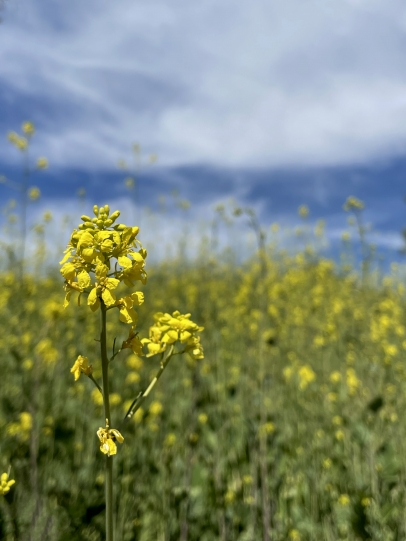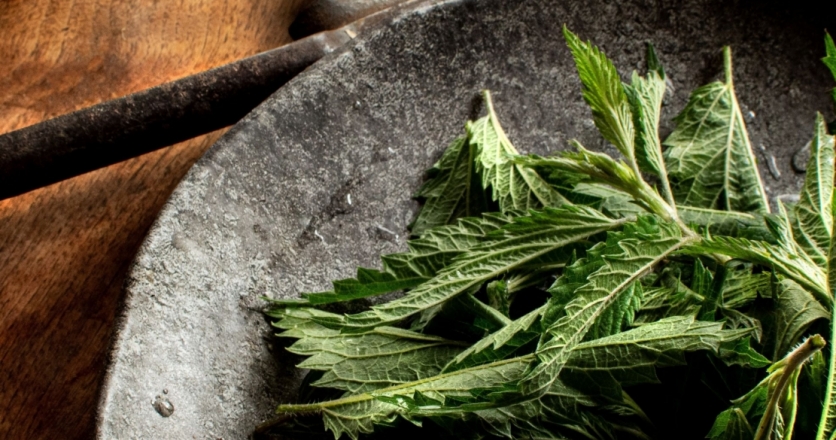To Forage or Not to Forage?
Drive or hike by any open space in Ventura County in the springtime and you’ll no doubt notice rolling hills of bright yellow flowers—wild mustard, one of California’s invasive plants. As human populations have moved across the world, plants and animals have followed, sometimes intentionally but often unintentionally. These nonnative organisms can cause serious problems as they outcompete native plants for their resources, leading to biodiversity loss and creating monocultures.
This displacement alters the delicate balance of the ecosystem, affecting every level of the food chain. Over $26 billion per year since 2010 has been spent in North America in the fight against invasive species to protect property values, agricultural returns and conservation of native landscapes. The conventional and cost-efficient way to deal with these plants has been to use controversial herbicides such as glyphosate and triclopyr—chemicals that ultimately end up in our soil and waterways, affecting native species and the whole ecosystem. Not to mention, these efforts have done little to make lasting change in restoration of natural habitats and often have to be retreated year after year.
But what if we EAT these invasive species instead?
Many of the problem-causing invasive species are actually edible and even medicinal. (Though some are very poisonous and even deadly, such as poison hemlock—please do you your research and consult a guide before eating any wild plant.) Some tasty edible invasive plants to look for are dwarf nettle (Urtica urens), purslane (Portulaca oleracea), the multitude of mustard species (Brassica sp.), chickweed (Stellaria media), common mallow (Malva neglecta), wild radish (Raphanus raphanistrum) and, of course, dandelion (Taraxacum officinale), among countless others. These plants are common in urban areas, gardens and lawns, parks, empty lots and open spaces. When foraging, be mindful of possible contaminants in high-traffic areas—you’ll be eating what the plant has absorbed throughout its life cycle.
Managing invasives isn’t just a springtime garden chore. Even in the fall and winter, once these plants have gone to seed many have edible seeds that can be collected and eaten. This prevents them from reseeding and expanding their population once spring comes around again. For example, wild mustard seeds (from species such as Brassica nigra or Hirschfeldia incana) can be collected to make the popular condiment of the same name. Plantain seeds can be used for their water-absorbing characteristic that is similar to chia. Others like cheatgrass and wild oats are grains that can be collected and used in place of commercial grains.
WHAT IS THE COST?
Naturally, conservationists oppose foraging of any kind. What if everyone did it? What if foragers took everything in their path? Won’t it disrupt an already fragile ecosystem?
The conservationists’ argument is valid in that undereducated foraging may cause damage to the environment with unethical harvesting practices and quantities. While their argument has merit—we don’t get foraging lessons in school and often lack any sort of immersive nature education—foraging wild food is much different than shopping at the local market and hardly likely to be as popular.
But on that topic, do we really know where our commercial food comes from? Even though we only see the neat little package from the supermarket, it originally came from a large swath of raw earth that was scraped clean of a diverse natural habitat (the same kind that conservationists are trying so desperately to protect) and replaced with a monoculture crop that displaces native inhabitants and depletes the soil of important nutrients within years.
How can we find a balance?
Psychology research indicates that the closer we are to nature, the more we interact with it on a daily basis and the more educated we are about the land around us, the more likely we are to respect and protect it. As the fight against invasive species continues, we can choose less harmful methods to seek balance in nature.
A specific example of working with imbalances in nature is the population of the purple sea urchin (despite being a native species), which in recent years has grown exponentially due to climate change. This population increase is destroying the kelp forests off the California coast. One effective way to control the purple urchin has been to encourage chefs to put them on the menu in hopes to reduce their numbers and regain balance in the kelp forests. This is an excellent example of managing the environment in a positive way by harvesting the excess.
AT HOME
Managing invasive species starts in your backyard by choosing native species when adding plants to your property and by harvesting those plants before they go to seed. This is also a great way to use native plants that would otherwise be illegal and/or unethical to collect in the wild.
Educating oneself on accurate species identification plus ethical and sustainable harvesting practices is crucial to introducing foraging as a positive method to managing the landscape.






